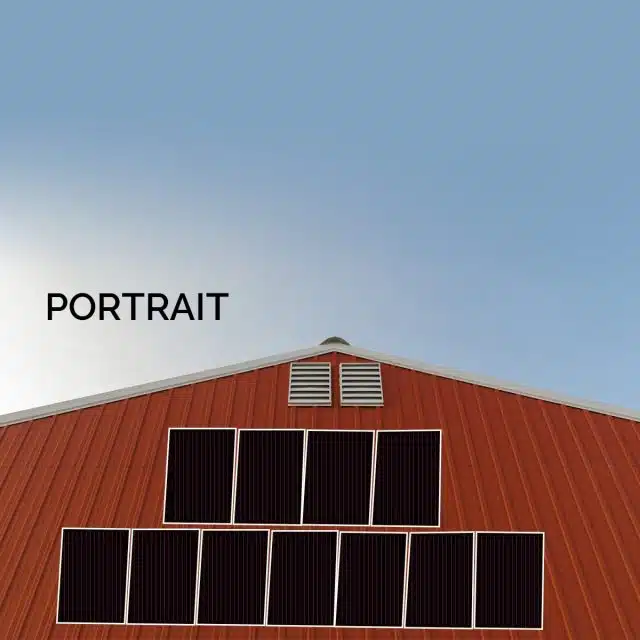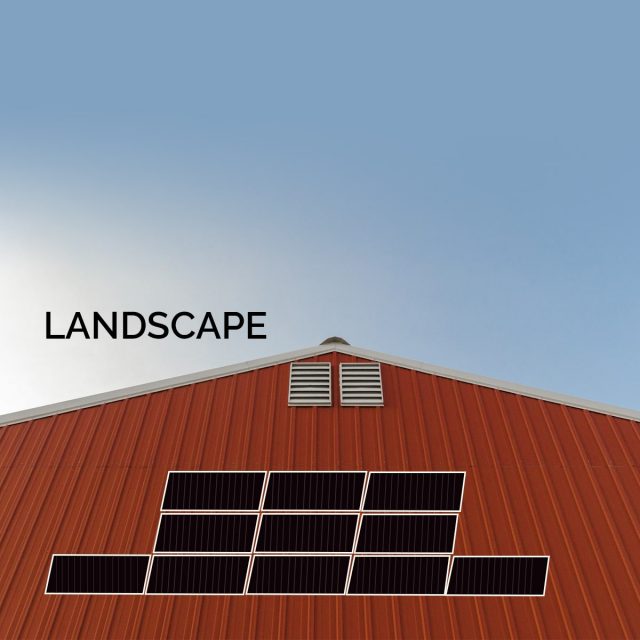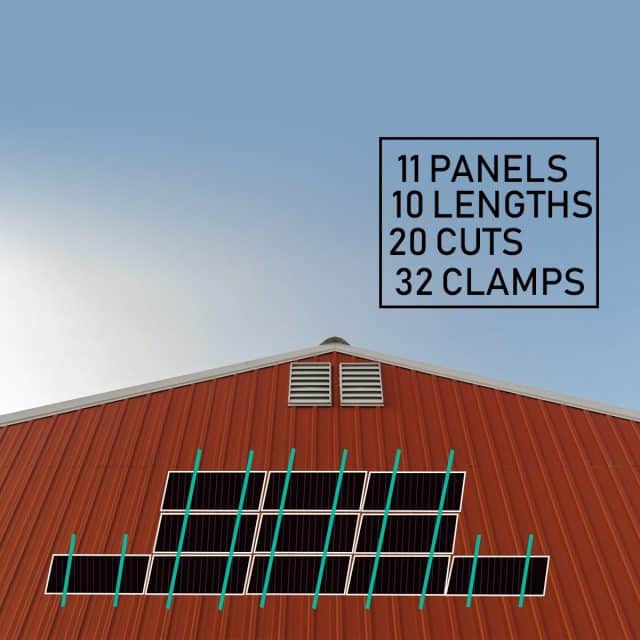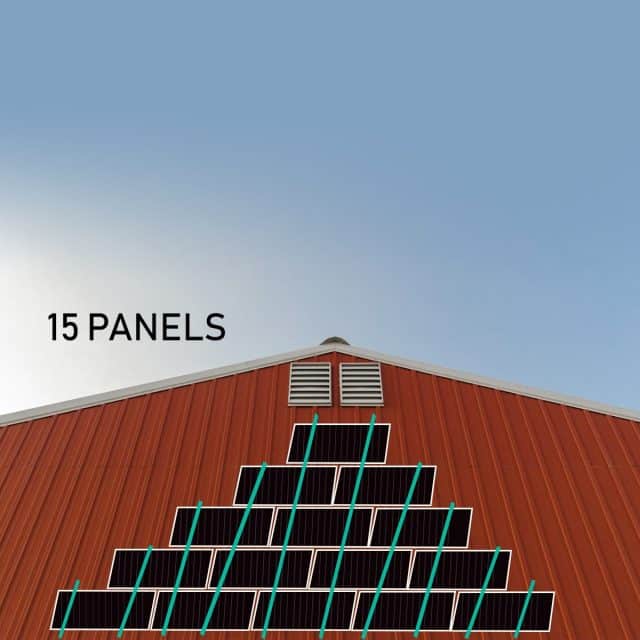Have you ever found that the majority of photovoltaic cells installed on roofs in Australia are fixed in portrait alignment? Portrait alignment is more widespread as it’s reasonable and faster to install solar panels in this way.
In today’s post, our solar experts at Vista EC will explain why the alignment of solar panels in Perth is an important matter and why you might be wealthier with landscape solar panels even though they require more effort for installation.
Point to be noted: Today’s post isn’t related to energy earned. With respect to energy earned, a portrait panel that is not shaded will produce the same amount of electricity as a landscape solar panel.
So, which alignment for Solar panel installation is better? Portrait Vs. Landscape
Assume you wish to set up 11 panels on a standard colour bond roof. You can put them in portrait-like shown below:
image title: Standard portrait orientation solar installation
Or you can install solar panels in landscape orientation as shown below:
Image title: Standard landscape solar panel installation
Which orientation is better?
If you look at the rooftops in both the images above, nearly all solar installers will choose to install PV panels in portrait orientation. Because, as mentioned above, it’s cheaper and quicker to install them in this manner. In reality, a landscape solar installation could take 50% longer.
Let’s find out why.
During portrait solar installation, the solar installers in perth will need to cut and install 4 lengths of rail, and use 26 clamps for installing the panels:
On the contrary, for landscape solar installation, the installer will need 10 lengths of rail and 32-panel brackets.
** This image shows where the mounting rails would typically go on a landscape installation. **
It might be possible to deploy parallel 6 rails with a longer edge of the solar panels, but the screw line spacing and screwing zones of the roof could make it difficult to do.
Therefore, why select landscape solar installation when extra efforts are required?
The simple answer is – space efficiency! On the majority of roofs, a landscape orientation will allow you to install more photovoltaic panels in the same space while taking care of clamping and exclusion zones of the roof. This signifies you can produce more electricity from the same roof.
For example – let’s use the same roof as before. With portrait alignment and allowing a 200mm exclusion zone surrounding the roof edge, you could fix 12 PV panels.
However, using landscape orientation, we can fit 15 panels.
**image of 15 panels landscape orientation**
A total of 15 solar panels will fit in landscape orientation on the same roof, along with exclusion and clamping zones. Thus, you can earn extra kilowatts from landscape orientation, which can be considerable.
Now let’s look at some of the full roofs with a few complicated roof faces, for example:
With a portrait solar installation, you can fit 47 panels.
** Complicated roof faces with 47 portrait panels** In the following roof, 47 panels can be installed with portrait orientation, except the south roof**
Whereas with a landscape panel installation, you can fit 57 panels and assume that they’re 400-watt solar energy panels, which will be an additional 4 kW on the roof.
Hurried solar installers won’t fix landscape panels.
Amongst the many reasons for receiving the cheapest solar quote is that the solar installers don’t have time or fondness for installation in landscape alignment.
In order to fit complete panels you’ve been sold on your rooftop, they might have to –
- Forcefully fit them in portrait, infringing either the PV panel clamping zones or the exclusion zones of the roof or both.
- Or told you, you can’t install all the panels you’ve been promised because they won’t fit.
Suppose you’ve bought 15 solar energy panels for the following type of roof, and if the
A salesperson has viewed your roof only on Google Maps, and then it might look like they’ll comfortably fit on the roof in a portrait manner.
But when the solar installer has been asked to fit them, and at the same time he’s in a hurry, then here’s what can happen:
He can fit them by ignoring exclusion zones, and you could have seen this all the time during the hurried panel installations.
The above installation process is the quickest and cheapest way for a hurried solar installer to install those 15 solar panels. Regrettably, to make room for them, the solar installer violates the 200mm exclusion zones needed to achieve AS 5033, i.e. Australian Standard for solar panel installations.
If you look carefully, the installation is non-compliant, doesn’t look good, and during the rainy season, the water that strikes the panels will likely pour off the bottom row like a small waterfall and completely miss your gutter.
At the same time, if the existing screw lines of the roof aren’t in a proper position with respect to the solar panels, then you might have PV panel clamps at the improper place, compared to the short edge of the panel- negating the warranty of the panel manufacturer.
Be aware of a salesperson who doesn’t consider landscape installation.
At times, some customers ask for help from us, who get quotes from outside of Vista EC, where salespeople are panning their competition, arguing that there are more panels than will fit on your rooftop.
Generally, it’s because the complaining salesperson hasn’t thought of landscape alignment.
Shortly, most Australian homes will have all-electric energy like electric-powered heating, electric-powered cooking, electric-powered hot water heaters, batteries, and an electric-powered car, etc. So in order to power these devices, it’s important to install solar power systems. Based on the shape of your roof, it’s best to choose a landscape solar. But don’t choose a cheap retailer!
Conclusion:
In the case of shade patterns, you’ll earn more electricity in a specific alignment because of the way the shadow moves up the panel. At the same time, the wiring could be tougher. The south-facing roof is excluded, but there’s no problem with fixing panels on the south-directing roof in Australia. Always get your designs from a qualified solar designer and choose a reputed solar panel installer who’ll accurately sketch the design.




